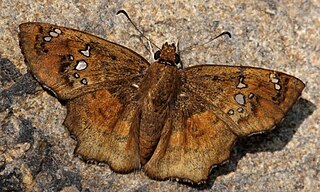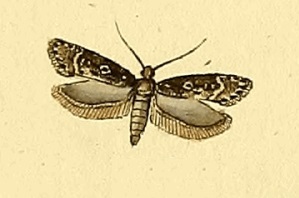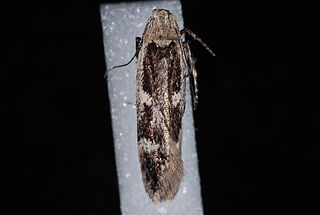
Abaratha agama, the spotted angle, is a species of butterfly belonging to the family Hesperiidae. It is found from southern India to Myanmar and in Thailand, Laos, Vietnam, southern China, Java and Sulawesi. The species was first described by Frederic Moore in 1857.

Panaeolus tropicalis is a species of psilocybin producing mushroom in the family Bolbitiaceae. It is also known as Copelandia tropicalis.
Barticeja is a genus of moths in the family Gelechiidae. It contains the species Barticeja epitricha, which is found in Brazil and Guyana.

Gelechia sororculella, the dark-striped groundling, is a moth of the family Gelechiidae. It is widely distributed from Europe, throughout Siberia to the Russian Far East.
Neotelphusa ochlerodes is a moth of the family Gelechiidae. It is found in Namibia.
Gelechia anagramma is a moth of the family Gelechiidae first described by Edward Meyrick in 1921. It is native to South Africa.
Gelechia lactiflora is a moth of the family Gelechiidae first described by Edward Meyrick in 1921. It is found in Mozambique.
Gelechia anthracopa is a moth of the family Gelechiidae. It is found in China (Shanghai).
Gelechia badiomaculella is a moth of the family Gelechiidae. It is found in North America, where it has been recorded from Kentucky.

Gelechia dromicella is a moth of the family Gelechiidae. It is found in North America, where it has been recorded from British Columbia, California, Colorado, Oklahoma, Saskatchewan and Washington.
Gelechia epiphloea is a moth of the family Gelechiidae first described by Edward Meyrick in 1913. It is found in South Africa.
Gelechia resecta is a moth of the family Gelechiidae first described by Edward Meyrick in 1913. It is found in South Africa.
Gelechia sematica is a moth of the family Gelechiidae first described by Edward Meyrick in 1913. It is found in Namibia and South Africa.
Gelechia fecunda is a moth of the family Gelechiidae first described by Edward Meyrick in 1918. It is found in South Africa.
Gelechia flexurella is a moth of the family Gelechiidae. It is found in North America, where it has been recorded from Pennsylvania.
Gelechia liberata is a moth of the family Gelechiidae. It is found in South Africa.
Gelechia monella is a moth of the family Gelechiidae. It is found in North America, where it has been recorded from British Columbia, Oregon, Wyoming and California.
Gelechia melanoptila is a moth of the family Gelechiidae. It is found in Australia, where it has been recorded from New South Wales.
Gelechia traducella is a moth of the family Gelechiidae. It was described by August Busck in 1914. It is found in Panama and Brazil.
Gelechia ribesella is a moth of the family Gelechiidae. It was described by Vactor Tousey Chambers in 1875. It is found in North America, where it has been recorded from Mexico, California, Colorado, Oregon and British Columbia.



